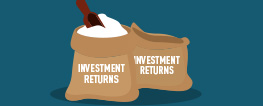
Fixing Funded Status:
Demand action to help solve Arizona's
$14 billion pension crisis
Financial markets and demographic trends changed faster than the state could adapt.
Now the ASRS pension system faces a funding challenge that threatens retirement
security for public workers.1
Educate yourself – and demand action to help retirement system leaders fix this.
The basics of funded status in Arizona
Your pension has been promised to you
Regular contributions from public workers like you and your employer sets money aside to be invested by the Arizona State Retirement System (ASRS) for retirement benefits, including your pension – your slice of the pie for life.
ASRS is falling behind
For many years, the state has set overly optimistic assumptions about investment returns, resulting in a massive shortfall. To help the state keep up, public employees are required to contribute more and more money to ASRS.
Is this fair to you?
Arizona should stop forcing public employees to foot the bill for bad legislative policies and pension fund mismanagement. It’s time to set a path to fully funding your pension through a responsible approach to funded status.
What is funded status – and why does it matter?
Watch this video for starters
Share the Challenge
Email
What is funded status – and why does it matter?

Funded status measures how much money ASRS should have
Money in the fund is compared to how much money it needs to pay retiree benefits, plus costs to run the fund. With the right decisions to achieve fully-funded status, ASRS is supposed to have enough money for today while also investing for the future.

Public employees and employers split contributions
Unlike most plans nationwide, 50% of ASRS contributions come from public employees and 50% from public employers. These contributions play a significant role in the plan’s funded status.

ASRS invests these contributions
The ASRS pension board works with advisors to invest the fund’s assets in stocks, bonds, hedge funds, real estate and more. Returns on these investments are key ingredients in the funded status recipe.

ASRS hasn't been fully-funded since 20022
Employees and employers have met all contribution levels and the fund has earned investment returns. But ASRS still hasn’t built up enough money to be able to pay all benefits to retirees today – and in the future.
The real danger of the $14 billion funded status shortfall.3
ASRS pensions are still being paid to retirees — the state constitution mandates it. But with a $14 billion shortfall, ASRS lacks assets and investment returns needed to pay future benefits. Even worse, the state continues to fall behind – it’s like always being short on ingredients to make more retirement pies.
How did Arizona let this happen?

ASRS was overly optimistic on investment returns
For decades, ASRS projected its investments to return 8% annually. But since 2001, they’ve earned only 5.7%.4 ASRS slightly reduced its investment expectations last year, but still uses an overly-optimistic Assumed Rate of Return.

The state is adding new debt while old debt lingers
Until 2014, ASRS consistently reset its pension debt payment schedule over a 30-year period, similar to resetting a house mortgage every year. Debt payments were often less than the interest on the debt, making existing debt even more expensive over time.

People are living longer than originally expected
The average U.S. lifespan in 1979 was 73.8 years.5 Today, it’s 78.7 years.6 Like many other plans, ASRS did not anticipate this kind of change. And this makes the shortfall larger.

AZ has paid its bills on time, but it isn’t enough
Unlike some states, AZ has been disciplined about paying pension bills each year without taking money out of the fund. But because of overly optimistic Assumed Rates of Return, state and local employers weren’t asked to contribute enough.

ASRS is playing catch up – and it’s impacting you.
As the state continues to choose overly optimistic assumed rates of return that aren’t met, you’re feeling it in your wallet. In fact, 11.94% of your salary now goes to pension contributions. In 2001, it was only 2%.7 That’s more than a 5x increase in less than 20 years – with no promise it won’t get worse. In addition, the state’s lack of funds can lead to raises that are smaller than expected.
You’re also feeling the impact of ASRS funded status shortages in…

Your pension
Retired? ASRS has run out of funds for post-retirement benefit increases. And public employees hired after 2013 have no promised cost-of-living adjustment at all. So pensions will stay the same while inflation makes things more expensive.

Your taxes
As pension debt rises, taxes on property owners often increase – and some AZ cities have raised sales taxes as well. Whether you’re working or retired, this means less money for everyday living.

Other public programs
Funding for roads, schools, parks and environmental programs, public housing and other municipal services are being cut as pension debt takes a bigger bite from public budgets.
Explore Funded Status for ASRS in-depth and demand improvements
In the early ’90s, ASRS benefits were 9% of the AZ economy. Legislative decisions and an expanded public workforce now mean promised benefits exceed 15% of state GDP.8 The challenges require action now – and you can help bring about improvements by learning more about the challenges facing ASRS,
then contact your state and local representatives to demand improvements.
Let’s take action together.
Arizona should stop forcing public employees to foot the bill for bad policies and pension fund mismanagement, and set a path to fully funding ASRS instead. Here’s what you can do.
Contact your state and local representatives
Sustained communication from educated, informed voices like yours can play a key role in fixing funding status for ASRS. Contact your state and local representatives now.
Share with a friend
Help amplify our message by spreading the word through your favorite social media channels.
Learn more
Equable is committed to helping you learn more about the challenges facing pensions today.
Connect with us
Learn how to join the growing numbers of employees, employers, policy makers and others working together to address the funded status challenge and create real retirement plan sustainability and affordability.
1ASRS is a retirement system offering pension benefits based on final average salary. The system serves most civilian public workers in Arizona, including teachers, university employees, most municipal workers, and state agency employees. Separate retirement systems cover police, firefighters, corrections officers, elected officials, and city of Phoenix employees.
2Equable Institute analysis of ASRS financial reports
3Equable Institute analysis of ASRS financial reports
4Equable Institute analysis of ASRS financial reports
5The World Bank, "Life Expectancy at Birth, Total (Years) - US," 1960-2017
6Fortune, “U.S. Life Expectancy Declines for Second Year,” 2017
7Equable Institute analysis of ASRS financial reports
8Equable Institute analysis of ASRS financial reports

